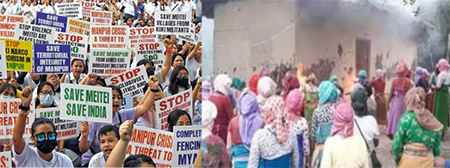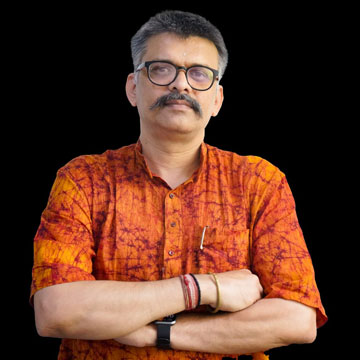“I have said that today is the proudest day of my life. For an enslaved people, there can be no greater pride, no higher honour, than to be the first soldier in the army of liberation. But this honour carries with it a corresponding responsibility and I am deeply conscious of it. I assure you that I shall be with you in darkness and in sunshine, in sorrows and in joy, in suffering and in victory. For the present, I can offer you nothing except hunger, thirst, privation, forced marches and deaths. But if you follow me in life and in death – as I am confident you will – I shall lead you to victory and freedom. It does not matter who among us will live to see India free. It is enough that India shall be free and that we shall give our all to make her free. May God now bless our army and grant us victory in the coming fight”. — Netaji Subhash Chandra Bose, on July 5, 1943, in Singapore after taking over the charge of President of the Indian Independence League
The iconic words of Netaji still resonate in the historic site of Moirang, just a few kilometres from Imphal, the capital city of Manipur. Moirang is the same place where the advanced headquarters of Azad Hind Fauz (INA) was located in 1943-44. All communities of the North East supported and participated in this historic struggle for Independence from colonial rule. What changed over the years that we cannot give all the communities a shared sense of freedom after seventy-five years?
The shameful video of two women being paraded naked on the roads went viral just a day before the opening of the monsoon session of the Parliament. Chief Minister of Manipur N Biren Singh called it a ‘crime against humanity’. Prime Minister Modi expressed grief and anger and assured that ‘no guilty would be spared’. The Supreme Court took suo-moto cognisance and expressed grave concern over the heinous crime. As multiple videos surfaced about the killings and crimes, women being paraded, it is clear that the viral video was not an isolated incident of inhuman acts by communities against each other. As per the report filed in the Supreme Court on July 10, 2023, as many as 5,995 FIRs have been filed, and 6,745 people have been taken into custody to keep the situation under control. Six cases have been transferred to the CBI for further probe. The fundamental question is why the innocent, nature-worshipping tribal communities are getting involved in these kinds of inhuman acts. What is the root of this mindless violence and hatred for each other? We need to understand the nitty-gritty of the Manipur crisis.
The State of Manipur broadly has a majority local Meitei community (largely Vaishnavaite by tradition) and primarily resides in the Imphal Valley. The other two groups of various tribes, Kukis and Nagas (original inhabitants of Mizoram, Nagaland and some parts of present-day Myanmar & currently residing hill areas), have been traditional worshippers converted to multiple denominations of Christianity. Over the years, substantial numbers of Meiteis are also practising Christianity. At the root of more than month-long violence is the Guwahati High Court order concerning the long-standing demand of the indigenous Meitei community of Manipur to get included in the list of Scheduled Tribes. They had tribal status before signing the Merger Agreement with the Union of Bharat. The Guwahati High Court accepted the petition and asked the Tribal Affairs Ministry and the Government of Manipur to file the response in four weeks. Thus, the possibility of Meiteis getting tribal status was the immediate cause of the violence. When the High Court extended the period to consider the Meitei’s plea, the Supreme Court intervened and called the High Court’s decision ‘factually incorrect’. The Supreme Court’s approach further aggravated the matter, resulting in violence. Depending on the strength of the community, Meiteis and Kukis started targeting each other. Can we afford to see this merely as a conflict between Meitei vs Kuki or Vaishnavaites Vs Christian faith followers?
To get the answers to these questions, we need to understand the historical and socio-economic dimensions among the various communities in Manipur.
The present-day Manipur was among the areas where the British faced severe resistance. Thanks to the valour and conviction of the patriots like Bir Tikendrajit Singh, the Manipur kingdom, nurtured by the Bhakti tradition popularised by Rajarshi Bhagyachandra, remained a kingdom with a distinct religious-cultural identity. British had deported King Kulachandra and 22 other freedom fighters to Andamans after executing Bir Tikendrajit. Despite the indirect control of the British, till its merger with the Bharatiya Union in 1949, the Vaishnavaite tradition remained at the heart of Manipur, and Meitei became the proud carrier of the same. But, the British systematically created divisions in the surrounding areas and communities. Firstly, they divided the communities between hills and plains and introduced the inner line permit for anyone from the plain areas to enter hill forests. At the same time, foreign missionaries were given a free hand to destroy the local cultures and traditions and subsequently convert the people. The idea of a Crown Colony, carving out a separate Christian State in Asia, was the ultimate plan of the British, which the Church did not give up even after the end of the British Raj.
Unfortunately, even after Independence, the same British policies continued in the North East. The result was divisions, border conflicts, parallel governments, and armed groups running an insurgency-based industry. In the case of Manipur, the Land Reforms Act of Manipur in 1960 further perpetuated the discrimination against Meiteis, as they were not allowed to buy land in the hill areas. In the 1970s, another game of poppy fields and drug trafficking started in the hill areas with the illegal migration of Chin Kukis from Myanmar. With support from Union Home Ministry, the Manipur Government began to take strict action against the drug peddlers and the unlawful encroachers. Hence, vehemence in the name of tribal status to Meiteis.
We must address these historical fallacies to address the present social, economic and political claims. The three-member inquiry commission set up by the Centre and headed by former Chief Justice of Guwahati High Court Ajai Lamba should consider these historical roots of the present crisis and give comprehensive recommendations at the earliest.
The more significant problem of the Northeast lies in the misinformation campaign by the vested interests developed since the colonial period. The tyranny of distance after independence has resulted in a lack of information in the rest of Bharat about the socio-cultural dynamics in the Northeast. We must restore the consciousness about the glorious struggle of freedom fighters against the British and missionaries which is largely whitewashed.
The immediate priority should be restoring law and order, if necessary, with the help of armed forces. Such crime against women is against our ethos and brings shame to the entire nation. Any whataboutary & selectivism would be detrimental to the peace. Police inaction or passivity in Manipur or elsewhere adds fuel to the fire. Immediate action against the perpetrators to restore the sense of justice is imminent in Manipur. While doing so, there should be clear guidelines about handling the mobs, especially the women protesters. Using women groups as a shield to spread violence (as exhibited in the anti-CAA protests) and attacking women as political revenge (as happened in the case of West Bengal after the Assembly elections) are becoming new norms. Governments and courts should come out clearly on these issues instead of indicting the security personnel later. There is a need for greater restrictions on sharing anonymous videos and messages, as they can be convenient weapons in the hands of miscreants.
Just a month and a half back, for the first time after the Independence, the North Eastern people were responding to the peace and development process with better infrastructural, cultural and emotional connectivity and inclusion. It was an achievement of the Modi-led NDA Government. The primary intent behind the Manipur violence and unprecedented investment in giving it a global reach is to derail that process. The issues of the North East are complicated and multidimensional. Instead of addressing them as community or State issues, we need to approach them as a national concern to sustain the process of inclusive development in the bordering regions of Bharat. As a nation, we need to be more vigilant in the run-up to the 2024 Lok Sabha Elections, as there will be many more sinister plans to bring instability, friction and bad-name to Bharat in the coming months.




















Comments